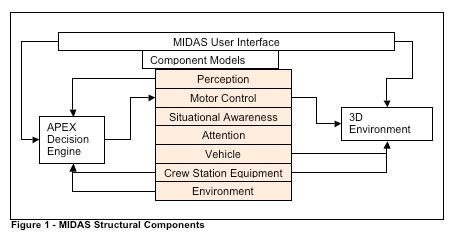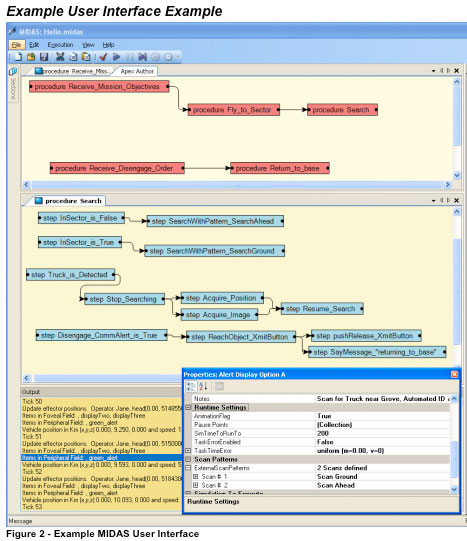MIDAS 4.0 was developed by Alion Science and Technology's Micro Analysis and Design Operations Division.
The Man-machine Integration Design and Analysis System (MIDAS) is a 3-D rapid prototyping human performance modeling and simulation environment that facilitates the design, visualization, and computational evaluation of complex man-machine system concepts in simulated operational environments. MIDAS combines graphical equipment prototyping, dynamic simulation, and human performance modeling with the aim to reduce design cycle time, support quantitative predictions of human-system effectiveness, and improve the design of crew stations and their associated operating procedures. MIDAS links a virtual human, comprised of a physical anthropometric character, to a computational cognitive structure that represents human capabilities and limitations. The cognitive component is made up of a perceptual mechanism (visual and auditory), memory, a decision maker and a response selection architectural component. The complex interplay among bottom-up and top-down processes enables the emergence of unforeseen, and non programmed behaviors. MIDAS outputs include dynamic visual representations of the simulation environment, timelines, task lists, cognitive loads along 6 resource channels, actual/perceived situation awareness, and human error vulnerability and human performance quality .
Executive Summary:
This document describes the MIDAS 4.0 features, with emphasis on those that are enhanced from previous versions of MIDAS.
For further MIDAS product information please contact Brian Gore at:
Brian Gore at
bgore@mail.arc.nasa.gov
(650) 604-2542
MIDAS version 4.0, Beta Edition, was released in the fall of 2006.
- Upgraded User Interface
- Unified Operating Environment, Windows XP, .NET 2.0
- Integration with 3D environment including anthropometric figure hosted on Windows XP.
- Unified code base, C#
Operating Environment:
The operating environment as well as the development environment for MIDAS 4.0 is Windows XP, .NET 2.0. All pre-existing MIDAS 3.0 SGI code has been re-hosted to Windows XP.
Although the MIDAS system is presented as an integrated environment to the user, there are four distinct structural components. These are the MIDAS user interface, the MIDAS component models, the 3D environment including the anthropometric model and the decision engine.

Midas User Interface and Component Models:
The user interface depicted in Figure 2, below, allows the user to parameterize the component models, set the simulation runtime settings and author operator procedures needed by the Decision Engine. The component models have been ported to C# .NET 2.0.
In addition, the UI parameterizes and opens socket connections to the Decision Engine and to the 3D environment. Once the sockets are open, the component models exchange information directly with APEX and the 3D environment.
3D Environment:
Beta version 4.0 utilizes the 3D environment in two ways. The first is to aid in the construction of the crewstation, the human operator and the vehicle. The second is to animate and validate human interactions with the crewstation.
In addition to the parameters needed by the component models, the MIDAS UI allows the user to choose for some parameters whether to use manual entry via the GUI or query the 3D environment for the parameters. These include the following.
- vehicle waypoints and initial vehicle location
- human operator and effector (hands & head) initial location
- Crewstation equipment size and location
> A wizard is provided to help the user align names of equipment in MIDAS with names of equipment in the 3D environment.
When a MIDAS model is executed, if the 3D environment is accessible and the animation flag has been enabled, the following actions are effected in the 3D environment every 100ms.
- The vehicle, operator and crew station equipment positions are updated based on the movement of the vehicle according to the selected guidance model.
- Depending on the state of fixation and scanning, the operator’s head and gaze are directed at the currently fixated object.
- If a reach-object or push-and-release action is currently tasked, the appropriate effector position is updated.
Apex Decision Engine:
The Apex Decision Engine dictates selection and sequence of operator procedures based on information from the perception model. Apex is a structurally different component from MIDAS. However, to the user, its usage is transparent. Unlike the 3D environment, Apex must be available to execute a simulation run.
Here is an example of the interaction between MIDAS and Apex. Given vehicle location with respect to a feature in the environment, visibility and lighting levels and scan pattern, the perception model will inform Apex when the perception level of the operator changes with respect to the feature. Likewise, scan patterns of the crewstation equipment coupled with dwell time effect perception level changes with respect to equipment. Given a perception level change and the operator procedures, Apex may initiate an operator task to the motor control model such as a reach-object, a speaking task or a change of scan pattern.

|